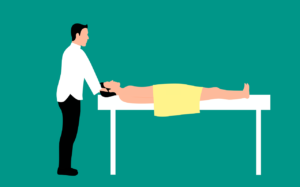
Are you tired of waking up with a stiff neck and achy shoulders? Look no further! In this article, we have compiled 5 simple stretches that will help alleviate your neck and shoulder pain during sleep. Say goodbye to sleepless nights and hello to a refreshing morning with these easy and effective stretches. So grab your pillow and get ready to relax those muscles for a good night’s sleep!
Stretching before sleep
Stretching before sleep is a simple and effective way to relieve neck and shoulder pain that may occur during sleep. While stretching may not completely eliminate the pain, it can help to alleviate muscle tension and promote relaxation, leading to a more comfortable night’s sleep. In this comprehensive article, we will explore the importance of stretching before sleep, the benefits it can provide, and the precautions to take before beginning a stretching routine.
Explanation of the importance of stretching
Stretching is essential for maintaining flexibility and range of motion in our muscles and joints. When we sleep, our bodies can become stiff and tense, especially in areas like the neck and shoulders that tend to hold stress and tension. By incorporating stretching into our bedtime routine, we can loosen tight muscles and promote better blood circulation, helping to alleviate discomfort and prevent further pain or stiffness.
Benefits of stretching before sleep
Stretching before sleep offers numerous benefits that can contribute to improved overall well-being. Some of the key benefits include:
- Relieves muscle tension: Regular stretching before bed can help to release tension in the neck and shoulder muscles, reducing pain and discomfort.
- Enhances relaxation: Stretching promotes the release of endorphins, known as “feel-good” hormones, which can help you relax and unwind before sleep.
- Improves sleep quality: By reducing muscle tension and promoting relaxation, stretching before bed can enhance the quality of your sleep, leading to a more restful night.
- Reduces stress: Stretching before sleep can help to relieve stress and calm the mind, allowing you to drift off to sleep more easily.
- Promotes better posture: Stretching exercises that target the neck and shoulders can help to improve posture, reducing the likelihood of developing neck and shoulder pain in the long run.
Precautions to take before beginning stretches
Before starting any stretching routine, it is essential to take some precautions to ensure that you do not cause any further pain or injury. Here are some precautions you should keep in mind:
- Consult with a healthcare professional: If you have any underlying medical conditions or chronic pain, it is advisable to consult with a healthcare professional before starting a stretching routine.
- Warm-up: Always warm up your muscles before stretching by performing light aerobic exercises or taking a warm shower. This helps to increase blood flow and prepares your muscles for stretching.
- Start gradually: Begin with gentle stretches and gradually increase the intensity and duration as your flexibility improves. Avoid pushing yourself too hard, as this can lead to injuries.
- Listen to your body: Pay attention to any discomfort or pain during stretching. If a stretch feels too painful, ease off or modify the stretch to suit your comfort level.
- Avoid bouncing: Avoid bouncing or jerking movements during stretching, as this can strain the muscles and lead to injury. Instead, focus on smooth and controlled movements.
By following these precautions, you can ensure a safe and effective stretching routine before sleep.
Stretch 1: Neck Tilt
Step-by-step instructions for neck tilt stretch
- Sit or stand with your spine upright and your shoulders relaxed.
- Slowly tilt your head to the right, bringing your right ear closer to your right shoulder. Hold this position for 15-30 seconds.
- Return your head to the center and repeat the stretch on the opposite side, tilting your head to the left. Hold for another 15-30 seconds.
- Repeat the tilt on each side 2-3 times, gradually increasing the duration of the stretch if comfortable.
Tips for proper form
- Ensure that your shoulders are relaxed and avoid shrugging them up toward your ears during the stretch.
- Keep your chin parallel to the ground and avoid tucking it into your chest or lifting it too high.
- Move in a slow and controlled manner, avoiding any sudden or jerky movements.
- Breathe deeply and relax your neck muscles as you hold the stretch.
Key points to remember
- Avoid any pain or discomfort during the stretch. If you feel sharp or intense pain, stop immediately and consult with a healthcare professional.
- Do not force your head to tilt beyond your comfortable range of motion. Gradually increase the intensity of the stretch over time.
- Incorporate the neck tilt stretch into your bedtime routine for optimal results in relieving neck and shoulder pain during sleep.

Stretch 2: Shoulder Roll
Step-by-step instructions for shoulder roll stretch
- Stand or sit with your back straight and your shoulders relaxed.
- Lift both shoulders up toward your ears, then roll them back in a circular motion.
- Continue rolling the shoulders back for 10-15 seconds.
- Reverse the direction and roll the shoulders forward for another 10-15 seconds.
- Repeat the shoulder roll 5-10 times, gradually increasing the speed and intensity if comfortable.
Tips for proper form
- Keep your neck relaxed and avoid shrugging or tensing it during the shoulder roll.
- Maintain a slow and controlled motion throughout the exercise.
- Engage your core muscles to support your spine and maintain good posture.
Common mistakes to avoid
- Avoid raising your shoulders excessively high, as this can lead to tension and discomfort.
- Do not rush through the shoulder roll. Take your time and focus on the movement and sensation in your shoulder muscles.
- If you experience any pain or discomfort, reduce the speed or range of motion.
By performing the shoulder roll stretch regularly, you can help to release tension in your shoulders and prevent stiffness and pain during sleep.
Stretch 3: Chin Tuck
Step-by-step instructions for chin tuck stretch
- Sit or stand with your back straight and shoulders relaxed.
- Gently tuck your chin inward, like you are trying to create a double chin.
- Hold this position for 10-15 seconds, feeling a stretch at the back of your neck.
- Release and repeat the chin tuck stretch 2-3 more times.
Benefits of chin tuck
- The chin tuck stretch helps to stretch and strengthen the muscles at the front of the neck, which can become weak and strained due to poor posture or prolonged sitting.
- It can also help to improve posture and reduce the risk of developing neck pain or headaches.
Variations of the chin tuck stretch
- To increase the stretch, you can gently press your palm against your forehead while performing the chin tuck.
- You can also try tilting your head slightly backward while tucking your chin to intensify the stretch.
By incorporating the chin tuck stretch into your bedtime routine, you can help to alleviate neck and shoulder pain and promote better posture.

Stretch 4: Neck Rotation
Step-by-step instructions for neck rotation stretch
- Sit or stand with your spine upright and shoulders relaxed.
- Slowly turn your head to the right, keeping your chin level with the ground.
- Hold this position for 10-15 seconds, feeling a gentle stretch on the left side of your neck.
- Return your head to the center and repeat the stretch by turning your head to the left.
- Complete 2-3 rotations on each side, gradually increasing the range of motion if comfortable.
Warnings for individuals with certain conditions
- If you have a history of spine or neck injuries, it is advisable to consult with a healthcare professional before attempting the neck rotation stretch.
- Individuals with osteoporosis or degenerative disc disease should also exercise caution and seek guidance from a healthcare professional.
How to modify the stretch for beginners
- If you are new to stretching or have limited flexibility, you can modify the neck rotation stretch by reducing the range of motion or using gentle, controlled movements.
- Start with smaller rotations and gradually increase the range as your comfort and flexibility improve.
The neck rotation stretch can help to improve flexibility in the neck muscles and relieve tension that may contribute to neck and shoulder pain during sleep.
Stretch 5: Shoulder Stretch
Step-by-step instructions for shoulder stretch
- Stand or sit with your back straight and shoulders relaxed.
- Extend your right arm straight in front of you at shoulder height.
- Take your left hand and place it on the outside of your right elbow.
- Gently pull your right arm across your chest, feeling a stretch in your right shoulder and upper back.
- Hold this position for 15-30 seconds, then release and switch sides.
Benefits of shoulder stretches
- Shoulder stretches like this can help to relieve tension in the muscles of the upper back and shoulders.
- They can also improve flexibility and range of motion in the shoulder joints.
Important tips to follow
- Avoid any sudden or jerky movements while performing the shoulder stretch.
- Breathe deeply and try to relax your shoulders as you hold the stretch.
- Only go as far as is comfortable for you, and avoid any pain or discomfort during the stretch.
Incorporating the shoulder stretch into your bedtime routine can help to relieve tension and promote relaxation in the neck and shoulder area.

Stretch 6: Upper Back Stretch
Step-by-step instructions for upper back stretch
- Stand or sit with your back straight and shoulders relaxed.
- Interlace your fingers in front of you, with your palms facing away from your body.
- Extend your arms forward, rounding your upper back and reaching as far forward as you comfortably can.
- Hold this position for 15-30 seconds, feeling a stretch in your upper back.
- Release and repeat the stretch 2-3 more times.
Precautions to take for individuals with back problems
- If you have a history of back problems or injuries, it is advisable to consult with a healthcare professional before attempting the upper back stretch.
- Individuals with conditions such as herniated discs or spinal stenosis should exercise caution and seek guidance from a healthcare professional.
Additional variations for a deeper stretch
- To deepen the stretch, you can try rounding your upper back even further and folding your body forward slightly.
- You can also experiment with slightly extending your arms upward while rounding your upper back.
By regularly performing the upper back stretch, you can help to alleviate tension and pain in the upper back and shoulders, promoting better sleep quality.
Stretch 7: Scalene Stretch
Step-by-step instructions for scalene stretch
- Sit or stand with your back straight and shoulders relaxed.
- Tilt your head to one side, bringing your ear closer to your shoulder.
- Place the hand on the same side of the tilt on top of your head and gently apply gentle pressure to enhance the stretch.
- Hold this position for 15-30 seconds, feeling a stretch on the opposite side of your neck.
- Release and repeat the stretch on the opposite side.
Explanation of the scalene muscles
- The scalene muscles are located on the sides of the neck and can become tight and contracted due to poor posture or excessive strain.
- Stretching these muscles can help to reduce tension and relieve neck and shoulder pain.
How to modify the stretch for beginners
- Beginners can modify the scalene stretch by reducing the intensity of the pressure applied to the head.
- Gradually increase the intensity of the stretch over time as your flexibility improves.
Incorporating the scalene stretch into your stretching routine before sleep can help to alleviate neck and shoulder pain and improve overall comfort.
Stretch 8: Shoulder Blade Squeeze
Step-by-step instructions for shoulder blade squeeze
- Sit or stand with your back straight and shoulders relaxed.
- Imagine squeezing a pencil between your shoulder blades.
- Pull your shoulder blades together and down, feeling a gentle squeeze.
- Hold this position for 10-15 seconds, then release.
- Repeat the shoulder blade squeeze 2-3 more times.
Benefits of shoulder blade squeeze
- The shoulder blade squeeze helps to strengthen the muscles between the shoulder blades, improving posture and reducing the risk of developing neck and shoulder pain.
- It can also help to relieve tension and discomfort in the upper back and shoulders.
Tips to maintain proper posture during the stretch
- Keep your chin parallel to the ground and avoid tucking it into your chest or lifting it too high.
- Engage your core muscles to support your spine and maintain good posture.
- Avoid arching your lower back or hunching your shoulders forward during the squeeze.
By incorporating the shoulder blade squeeze into your bedtime routine, you can strengthen the muscles of your upper back and shoulders, promoting better posture and reducing discomfort during sleep.
Stretch 10: Levator Scapulae Stretch
Step-by-step instructions for levator scapulae stretch
- Sit or stand with your back straight and shoulders relaxed.
- Tilt your head to one side, bringing your ear closer to your shoulder.
- Place the hand on the same side of the tilt behind your back and gently apply gentle pressure to enhance the stretch.
- Hold this position for 15-30 seconds, feeling a stretch at the back of your neck.
- Release and repeat the stretch on the opposite side.
Benefits of levator scapulae stretch
- The levator scapulae stretch targets a key muscle in the neck that often becomes tight and strained due to poor posture or stress.
- By stretching this muscle, you can relieve tension and reduce neck and shoulder pain.
Important tips to prevent strain
- Avoid any sudden or jerky movements while performing the levator scapulae stretch.
- Breathe deeply and try to relax your neck and shoulder muscles as you hold the stretch.
- Only go as far as is comfortable for you, and avoid any pain or discomfort during the stretch.
Incorporating the levator scapulae stretch into your bedtime routine can help to alleviate tension and pain in the neck and shoulders, promoting a more comfortable and restful sleep.







